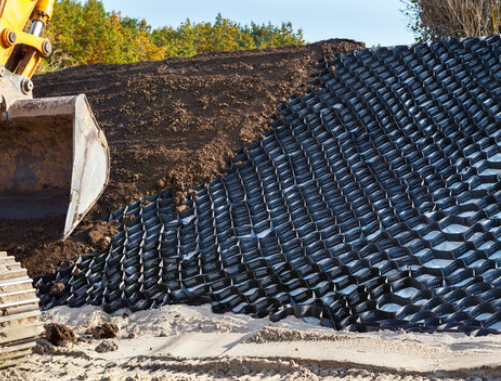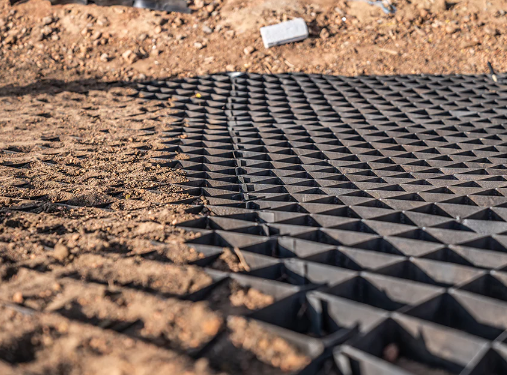- Understanding the Role of Geomembrane Liners in Waste Management
- Innovations in Geomembrane Liners for Water Management
- Geomembrane Liners: A Comprehensive Guide
- The Future of Geomembrane Liners in Civil Engineering
- Geomembrane Liners: Enhancing Landfill Stability
Manager:Alvin Wang
WhatsApp:+62 8983806051
Tel:+86 10-5797-1075
Email:steelwang@okorder.com
Address:3rd Floor, No.2 Building, No.1 Sanlihe Road
What is the spacing for geogrids?
Geogrids are very important to various civil engineering and construction activities as they offer reinforcement and stability to soils and aggregates. Among many types, plastic geogrid, wholesale geogrid, fiberglass geogrid, glassfiber geogrid are some of the most popular ones each with its own distinct features and uses. To ensure optimal performance and durability in different construction scenarios, it is important to understand the right spacing for these geogrids.

Introduction to Geogrids:
These have a grid structure that consists of a number of square or rectangular apertures made up from polymers such as polyethylene (PE), polyester (PET) or fibreglass. These materials are designed to withstand high tensile forces and distribute loads effectively making them particularly valuable in soil reinforcement slope stabilisation pavement construction.
Plastic Geogrid:
Manufactured using either High-Density Polyethylene (HDPE) or Polypropylene (PP), Plastic geogrids resist chemical degradation as well as biological decay. These are commonly used in road construction projects, retaining walls structures including reinforced slopes. Depending on factors like loading conditions project specifications among others the spacing for plastic geogrid installation varies between 0.5m by 2 m; closer measurements being for weaker soils or higher loads.
Wholesale Geogrid:
On large-scale infrastructure developments such as roads, railways and embankments bulk quantities purchased together make wholesale grids possible. The material composition and tensile strengths may differ but the spacing requirements align with specific engineering standards and design calculations. Contractors find this economical while adhering to quality standards.
Fiberglass Geogrid:
For mechanical properties’ enhancement these normally contain polymer resins coated high-strength glass fibers which help improve their durability hence overcoming environmental factors such as creepage often found in long-term applications like road pavements airport runways foundation stabilization. Sub-grade conditions project requirements and pavement design parameters dictate the spacing for fiberglass geogrid installation. For heavy traffic areas and critical structures, close spacing is preferred; typically between 0.3 to 1.5 m.
Glassfiber Geogrid:
Like fiberglass geogrids, these are made of glass fiber embedded in a polymer matrix. Reinforcing asphalt concrete overlays, soil stabilization load transfer platforms are some ideal applications where high tensile strength and stiffness make them useful for this purpose. Based on subgrade conditions pavement design parameters and project requirements the spacing for glassfiber geogrid installation is arrived at. Thus geotechnical analysis and structural calculations help engineers optimize spacing so as to give adequate support and reinforcement.
Factors Influencing Geogrid Spacing:
Several factors influence the spacing of geogrids in construction projects:
1.Soil Type and Properties: The characteristics of the underlying soil, including cohesion, shear strength, and permeability, dictate the spacing and depth of geogrid installation to achieve desired stability and reinforcement.
2.Loading Conditions: The magnitude and distribution of applied loads, such as traffic loads for roads or surcharge loads for retaining walls, influence the spacing and orientation of geogrids to resist deformation and maintain structural integrity.
3.Design Standards and Guidelines: Engineering standards-geogrid spacing recommendations found in specific project requirements safety factors performance criteria which ensure compliance with industry best practices regulatory requirements
4. CONSTRUCTION METHODS: The manner in which geogrids are installed, including mechanical means, rolling, or tensioning methods of placement influences the way spacing and alignment is done to ensure proper integration with surrounding soil or aggregate layers and reduce installation errors or defects.

Conclusion:
In conclusion, one must understand the minimum requirement for space for plastic geogrids wholesale geogrids , fiberglass geogrids and glassfibergeogird to be successfully adopted as construction materials. By considering factors such as soil properties, loading conditions, design standards and construction techniques, engineers and contractors can optimize its placement so as to improve its structural stability, durability and performance hence sustainable cost-effective infrastructure solutions.”
-
2024-06-12Asphalt fiberglass geogrid construction plan
-
2024-06-04Asphalt fiberglass geogrid construction plan
-
2024-05-21What is the disadvantage of geogrid?
-
2024-05-21What is the lifespan of geogrid?
-
2024-05-21What are the 3 main uses of a geotextile?






